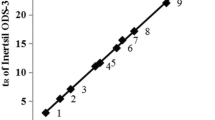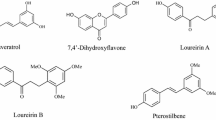Abstract
A simple and facile gas chromatography-mass spectrometer (GC-MS) fingerprint of Su-He-Xiang-Wan (SHXW) was developed, the similarity analysis was conducted, and attribution of the major characteristic peaks was identified for SHXW quality control. GC-MS analysis was performed on a QP2010 instrument (Shimadzu, Japan) equipped with a capillary column of RTX-5MS. The column temperature was initiated at 50 °C, held for 5 min, increased at the rate of 3 °C/min to 120 °C, held for 2 min, and then increased at the rate of 4 °C/min to 220 °C, held for 10 min. Helium carrier gas was used at a constant flow rate of 1.3 mL/min. Mass conditions were ionization voltage, 70 eV; injector temperature, 250 °C; ion source temperature, 250 °C; splitting ratio, 30:1; full scan mode in the 40–500 Da mass ranges with rate of 0.2 s per scan. Attribution of the major characteristic peaks was identified for SHXW by comparing the chemical standards, references of Chinese herbal medicines and the negative controls of prescription samples (NC) of SHXW. With the help of the temperature-programmed retention indices (PTRIs) used together with mass spectra and chemical standards, 25 major characteristic peaks have been identified. Nine volatile medicinal materials were identified in the prescription of SHXW by attributing to the 27 major characteristic peaks. The results demonstrate that the proposed method is a powerful approach to quality control of complex herbal medicines.
Similar content being viewed by others
References
The State Commission of Chinese Pharmacopoeia. Chinese Pharmacopoeia (part I) [M]. Beijing: Publishing the Medicine Science and Technology Press of China, 2010, 742–743. (in Chinese)
LIANG Yi-zeng, XIE Pei-shan, CHAN K. Quality control of herbal medicines [J]. Journal of Chromatography B, 2004, 812: 53–70.
XIE Pei-shan, CHEN Si-bao, LIANG Yi-zeng, WANG Xiao-hong, TIAN Run-tao, UPTON R. Chromatographic fingerprint analysis—A rational approach for quality assessment of traditional Chinese herbal medicine [J]. Journal of Chromatography A, 2006, 1112(1/2): 171–180.
LUO Guo-an, WANG Yi-ming. Classification and development of TCM fingerprint [J]. Chinese Journal of New Drugs, 2002, 11: 46–51. (in Chinese)
YAN Shi-kai, XIN Wen-feng, LUO Guo-an, WANG Yi-ming, CHENG Yi-yu. An approach to develop two-dimensional fingerprint for the quality control of Qingkailing injection by high-performance liquid chromatography with diode array detection [J]. Journal of Chromatography A, 2005, 1090: 90–97.
CHENG Yi-yu, CHEN Min-jun, WILLIAM J W. Fractal fingerprinting of chromatographic profiles based on wavelet analysis and its application to characterize the quality grade of medicinal herbs [J]. J Chem Inf Comput Sci, 2003, 43: 1959–1965.
World Health Organization. General Guidelines for Methodologies on Research and Evaluation of Traditional Medicine [R]. Geneva, 2000.
XIE Bao-gang, GONG Tao, TANG Ming-hai, MI Dan-feng, ZHANG Xuan, LIU Jie, ZHANG Zhi-rong. An approach based on HPLC-fingerprint and chemometrics to quality consistency evaluation of Liuwei Dihuang pills produced by different manufacturers [J]. Journal of Pharmaceutical and Biomedical Analysis, 2008, 48: 1261–1266.
LIANG Xu, ZHANG Xi, DAI Wei-xing, LV Yong-hai, YAN Shi-kai, ZHANG Wei-dong. A combined HPLC-PDA and HPLC-MS method for quantitative and qualitative analysis of 10 major constituents in the traditional Chinese medicine Zuo Gui Wan [J]. Journal of Pharmaceutical and Biomedical Analysis, 2009, 49: 931–936.
ZHANG Xiao-gang, HAN Ting, ZHANG Qiao-yan, ZHANG Hong, HUANG Bao-kang, XU Li-li, QIN Lu-ping. Chemical fingerprinting and hierarchical clustering analysis of centella asiatica from different locations in China [J]. Chromatographia, 2009, 69: 51–57.
SHI Cong-wen, ZHU Wen-cai, YAO Fa-ye. A Study on chemical constituents for the essential oil of liquidambar orientalis mill [J]. Journal of Shan-dong Education Institute, 2009, 3: 80–83. (in Chinese)
YAO Fa-ye, ZHU Wen-cai, QIU Qing, LIU Ting-li. The chemical constituents of storax volatile oil by supercritical CO2 fluid extraction and steam distillation extraction [J]. Chinese Traditional and Herbal Drugs, 2008, 39: 1151–1153. (in Chinese)
The State Commission of Chinese Pharmacopoeia Chinese Pharmacopoeia (part I) [M]. Beijing: Publishing the Medicine Science and Technology Press of China, 2005: 57. (in Chinese)
DOOL H V, KRATZ P D. A generalization of the retention index system including linear temperature programmed gas-liquid partition chromatography [J]. Journal of Chromatography A, 1963, 11: 463–471.
US National Institute for Science and Technology (NIST) MS Data Central NIST standard reference database 69 [EB/OL]. 2005. http://www.webbook.nist.gov.
GONG Fan, LIANG Yi-zeng, XIE Pei-shan, CHAU Foo-tim. Information theory applied to chromatographic fingerprint of herbal medicine for quality control [J]. Journal of Chromatography A, 2003, 1002: 25–40.
LU Hong-mei, LIANG Yi-zeng, CHEN Shan. Identification and quality assessment of houttuynia cordata injection using GC-MS fingerprint: A standardization approach [J]. Journal of Ethnopharmacology, 2006, 105: 436–440.
YAN Shi-kai, ZHANG Wei-dong, LIU Run-hui, ZHAN Yong-cheng. Chemical fingerprinting of shexiang baoxin pill and simultaneous determination of its major constituents by HPLC with evaporative light scattering detection and electrospray mass spectrometric detection [J]. Chemical & Pharmaceutical Bulletin, 2006, 54(7): 1058–1062.
MARTENS H, NAES T. Multivariate calibration [M]. 2nd Ed. New York: Wiley, 1991.
WILLIAM J E, WILLIAM E B, STEPHEN L M, Measurement of carboxyhemoglobin in forensic blood samples using UV-Visible spectrometry and improved principal component regression [J]. Applied Spectroscopy, 1999, 53: 218–225.
SU De-min, YAO Fa-ye, SHI Zhu. Study chemical constituents of storax with supercritical CO2 extraction [J]. West China Journal of Pharmaceutical Sciences, 2005, 20(5): 409–411.
Author information
Authors and Affiliations
Corresponding author
Additional information
Foundation item: Projects(21275164, 21075138) supported by the National Natural Science Foundation of China
Rights and permissions
About this article
Cite this article
Wang, Wp., Lin, J., Zhang, Lx. et al. Chemical fingerprinting of Su-He-Xiang-Wan and attribution of major characteristic peaks for its quality control by GC-MS. J. Cent. South Univ. 20, 2115–2123 (2013). https://doi.org/10.1007/s11771-013-1715-4
Received:
Accepted:
Published:
Issue Date:
DOI: https://doi.org/10.1007/s11771-013-1715-4




